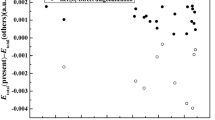Summary
Described here are new computational procedures which have been developed for obtaining the continuum orbital in Auger problems. A Lippmann-Schwinger (LS) equation is solved for the inner, atomic or molecular region and in the asymptotic region the LS orbital is matched with the eigenfunctions of the long-range Hamiltonian. A detailed analysis of the form of the continuum orbital for various decay states of the KLL Auger spectrum of the neon atom is presented. Decay rates are given for the Ne and compared with previous results and with experiments.
Riassunto
Si presenta una nuova tecnica per ottenere l'orbitale del continuo in problemi Auger. Essa consiste nella soluzione di un'equazione alla Lippmann-Schwinger (LS) per la regione atomica o molecolare e nel raccordo dell'orbitale cosí ottenuto con le autofunzioni dell'hamiltoniana contenente la parte asintotica del potenziale. Si effettua inoltre un'analisi dettagliata della forma dell'orbitale del continuo per vari possibili stati di decadimento Auger dell'atomo di Ne ionizzato nel guscio 1s e si interpreta lo spettro KLL di tale sistema in termini di energie di risonanza e velocitá di decadimento.
Резюме
В работе описываются новые вычислительные процедуры, которые были развиты для получения непрерывной орбитали в Оже-проблемах. Решается уравнение Липмана-Мвнгера для внутренней атомной или молекулярной области. В асимптотической области орбиталь Липмана-Швингера согласуется с собственными функциями Гамильтониана. В работе проводится подробный анализ формы непрерывной орбитали для различных возможных состояниЙ Оже-распада атома Ne. Приводятся интенсивности распада для Ne и сравниваются с предыдущими результатами и данными экспериментов.
Similar content being viewed by others
References
R. Colle, A. Fortunelli andS. Simonucci:Nuovo Cimento D,10, 355 (1988).
R. Colle andS. Simonucci:Phys. Rev. A (1989) (in press).
R. Colle, S. Simonucci andT. O. Woodruff:Phys. Rev. A,38, 694 (1988) and references therein.
M. Hotokka, H. Ågren, H. Aksela andS. Aksela:Phys. Rev. A,30, 1855 (1984).
A. W. Fliflet, D. A. Levin, M. Ma andV. McKoy:Phys. Rev. A,17, 160 (1977).
R. Colle, A. Fortunelli andS. Simonucci:Nuovo Cimento,9, 969 (1987).
H. P. Kelly:Phys. Rev. A,11, 556 (1975).
R. Colle, A. Fortunelli andS. Simonucci:Nuovo Cimento D,10, 805 (1988).
Handbook of Mathematical Functions, edited byM. Abramowitz andI. A. Stegun,Nat. Bur. Stand. Appl. Math. Ser.,55, 295, 538 (1964).
W. H. Press, B. P. Flannery, S. A. Teukolsky andW. T. Vetterling:Numerical Recipes (Cambridge University Press, Cambridge, 1986), p. 547.
Author information
Authors and Affiliations
Rights and permissions
About this article
Cite this article
Colle, R., Simonucci, S. The continuum orbital problem in the calculation of auger decay rates: Application to Ne. Il Nuovo Cimento D 11, 1587–1602 (1989). https://doi.org/10.1007/BF02451014
Received:
Issue Date:
DOI: https://doi.org/10.1007/BF02451014




